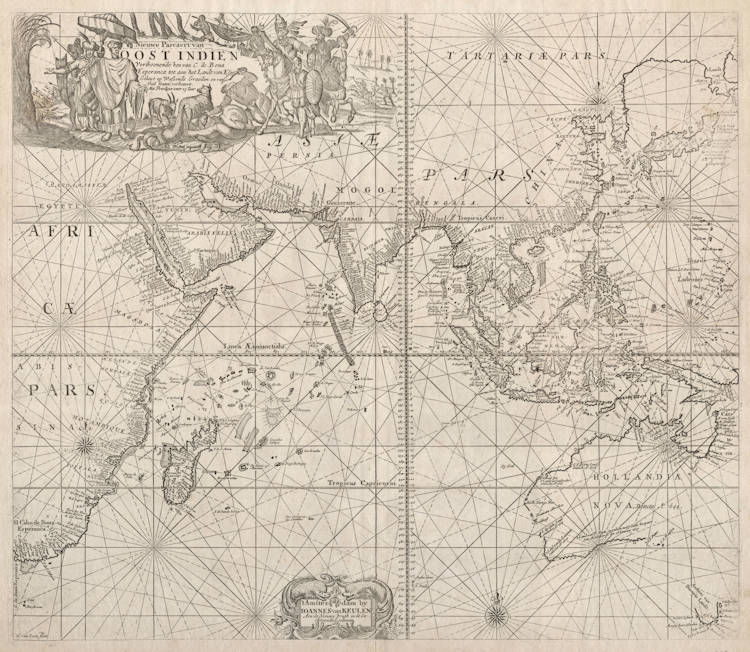Leen Helmink Antique Maps
Antique map of South East Asia and Australia by de Wit
The item below has been sold, but if you enter your email address we will notify you in case we have another example that is not yet listed or as soon as we receive another example.
Stock number: 18951
Zoom ImageCartographer(s)
Frederick de Wit (biography)
Title
Orientaliora Indiarum Orientalium cum Insulis Adjacentibus a Promontorio C. Comori ad Iapan. Pascaert van t' Ooster gedeelte van Oost Indien van C. Comorin tot Iapan.
First Published
Amsterdam, 1675
This Edition
1675 first edition
Size
43.9 x 54.0 cms
Technique
Condition
excellent
Price
This Item is Sold
Description
From Frederick de Wit's Sea Atlas Orbis Maritimus ofte Zee Atlas. Classical sea chart of South East Asia and Australia modeled after Pieter Goos' 1666 chart of the area. Tasman's discoveries of the Australian coast are given in detail. East is at the top of the map. A very decorative cartouche showing the people and the products of the far east.
This is the rare Frederick de Wit first edition first state of 1675 of this classic Dutch sea chart.
The chart was re-issued 40 years later in a second state (see example here) by Louis Renard in his Atlas de la Navigation et du Commerce. Amsterdam, 1715. The second state has a plate number "Fol.21." added in the upper right, and when colored it has the typical wash color that was fashionable in the 18th century, instead of the line coloring of the 17th century. A third state (see example here) was re-issued 70 years after the first state, by Reinier and Joshua Ottens, Amsterdam 1745. It has their imprint added ad the bottom of the cartouche, and Tasmania inserted.
Provenance: Ex Collection Geoffrey Allan Edwards (1947-2019)
Condition
Beautiful early line coloring from de Wit's publishing house. First edition, first state. Strong early imprint of the copperplate. Minimal strengthening of the verdigris (copper oxidation of the green colors) in Northern China and the title cartouche. Overall a very attractive example in collector's condition.
This very example of the chart is described and illustrated in Dr David E. Parry's The Cartography of The East Indian Islands - Insulae Indiae Orientalis, a cartobibliograpy of early mapping of South East Asia (page 120).
"The third map of the region produced by Frederick de Wit is a magnificent sea chart entitled Orientaliora Indiarum Orientalium. The chart was originally published in de Wit's maritime atlas Orbis Maritimus ofte Zee Atlas in 1675 and was modelled on a similar chart by Pieter Goos, that was published in De Zee-Atlas ofte Water-Wereld between 1666-83. This chart also served as the prototype for charts of the region by the English mapmaker John Seller and the Amsterdam-based French cartographer Louis Renard. The chart was also published in 1690 in de Wit's maritime atlas Tabulae Maritimae, ofte Zee-Karten, which generally appeared as Volume II of his World Atlas, a collection of 133 maps of the world by de Wit, J. Blaeu, J. Jansson, N. Sanson and others, that was published in the same year.
The chart, which is orientated with east at the top, shows the post-Tasman regional map of Australia and Papua New Guinea, in addition to the Southeast Asian region including the Indonesian and Philippine archipelagoes. The Torres Strait that separates Papua New Guinea from Cape York is still not shown although Torres passed through the straits some seventy-four years before in 1606.
The chart represents the eastern part of a pair of charts with the second chart, entitled Orientaliora Indiarum Indiarum Occidentalium, covering the Indian Ocean from the coast of East Africa and Saudi Arabia, to the west coast of the Indian subcontinent. De Wit's name does not appear anywhere on the eastern chart, but does appear in the cartouche of the western chart."
(Parry).
"This finely engraved map appeared in de Wit's Atlas Maritime, an atlas of sea charts covering the whole world. This is the most detailed chart of the Australian coasts, although the equivalent map of the Pacific includes Tasman's detail to the south."
(Potter).
Frederick de Wit (1630-1706)
Frederick de Wit was one of the most prominent and successful map engravers and publishers in Amsterdam in the period following the decline of the Blaeu and Jansson establishments, from which he acquired many copper plates when they were dispersed at auction.
His output covered most aspects of map making: sea charts, world atlases, an atlas of the Netherlands, ‘town books' covering plans of towns and cities in the Netherlands and Europe, and wall maps. His work, notable for the beauty of the engraving and colouring, was very popular and editions were issued many years after his death by Pieter Mortier and Covens and Mortier.
(Moreland and Bannister)
Related Categories
Related Items






